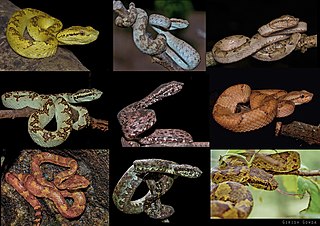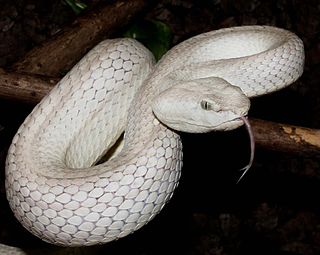
Trimeresurus is a genus of venomous pit vipers found in Asia from the Indian Subcontinent throughout Southeast Asia, China, and the Pacific Islands. Currently 44 species are recognized. Common names include Asian palm pit vipers, Asian lanceheads, and green pit vipers.
Tropidolaemus huttoni is a little-known species of pit viper, a venomous snake in the subfamily Crotalinae of the family Viperidae. The species is endemic to the southern Western Ghats of India. There are no subspecies that are currently recognized. Little is known about this species, as this species is known only from two young individuals, based on which it was first described in 1949. Despite long-term and targeted herpetological surveys in the particular hill range (Meghamalai), it has never been re-sighted there or elsewhere since then.

Protobothrops jerdonii, also known commonly as Jerdon's pitviper, the yellow-speckled pit viper, and the oriental pit viper, is a species of venomous snake in the subfamily Crotalinae of the family Viperidae. The species is native to India, Nepal, Myanmar, China, and Vietnam. Three subspecies are recognized, including the nominate subspecies described here.

Trimeresurus albolabris, the white-lipped pit viper or white-lipped tree viper, is a venomous pit viper species endemic to Southeast Asia.
Trimeresurus cantori, commonly known as Cantor's pit viper or Cantor's pitviper, is a species of venomous snake, a pit viper in the Subfamily Crotalinae of the family Viperidae. The species is endemic to the Nicobar Islands of India. It was named after Theodore Edward Cantor (1809-1860), a Danish naturalist serving as a surgeon with the East India Company in Calcutta. No subspecies are recognized as being valid.

Trimeresurus erythrurus, commonly known as the red-tailed bamboo pitviper, redtail bamboo pit viper, and redtail pit viper is a venomous pit viper species found in South Asia and Myanmar. No subspecies are currently recognized.

Craspedocephalus gramineus, known as the bamboo pit viper, Indian green pit viper, or common green pit viper, is a venomous pit viper species found in the southern and north eastern parts of India. No subspecies are currently recognized.

Craspedocephalus macrolepis, commonly known as the large-scaled pit viper, is a venomous pitviper species endemic to the Southern Western Ghats of South India. No subspecies are currently recognized.

Craspedocephalusmalabaricus, commonly known as Malabar pit viper, Malabar rock pit viper, or rock viper, is a venomous pit viper species endemic to the High-moderate elevations of western ghats of southwestern India.Recently this species complex was split into three different species, Craspedocephalus malabaricus, Craspedocephalus travancoricus, Craspedocephalus anamallensis.

Trimeresurus popeiorum is a species of venomous pit viper in the family Viperidae. The species is native to northern and northeastern parts of India and Southeast Asia. Common names include: Pope's pit viper, Pope's green pit viper, Pope's tree viper and Pope's bamboo pitviper.

Craspedocephalus trigonocephalus, the Sri Lankan pit viper, Ceylon pit viper, Sri Lankan green pitviper or locally, pala polonga, is a venomous pit viper species endemic to Sri Lanka. No subspecies are currently recognized.

Craspedocephalus puniceus is a venomous pit viper species endemic to Southeast Asia. Common names include: flat-nosed pitviper, flat-nosed pit viper, and ashy pit viper. No subspecies are currently recognized.

Trimeresurus sumatranus is a venomous pitviper species found in Thailand, Malaysia and Indonesia. Arboreal, its coloration is pale green with a red tail. Common names include Sumatran pitviper, Sumatran tree viper, and Sumatran pit viper.
Trimeresurus fasciatus is a venomous pit viper species endemic to Djampea Island, Indonesia. No subspecies are currently recognized. Common names include: banded pitviper and banded tree viper.

Craspedocephalus brongersmai, also known commonly as Brongersma's pit viper, is a species of venomous snake in the subfamily Crotalinae of the family Viperidae. The species is native to islands off the west coast of Sumatra, Indonesia. No subspecies are currently recognized.

Trimeresurus hageni, commonly known as the Hagen's pit viper, is a species of pit viper, a venomous snake, in the subfamily Crotalinae of the family Viperidae. The species is endemic to Southeast Asia. There are no subspecies that are recognized as being valid.
Trimeresurus tibetanus, commonly known as the Tibetan bamboo pit viper, is a venomous pit viper species found only in Tibet. No subspecies are currently recognized.
Trimeresurus gracilis, commonly known as the Taiwan pit viper or Taiwan mountain pitviper, is a venomous pit viper species endemic to Taiwan. No subspecies are currently recognized. The species is known as kikushi habu in Japanese.
Garthius chaseni, commonly known as Chasen's mountain pit viper, Chasen's tree viper, and the Kinabalu brown pit viper, is a species of venomous pitviper in the family Viperidae. The species is endemic to the island of Borneo in Malaysia. No subspecies are currently recognized. It is monotypic in the genus Garthius.

Trimeresurus mcgregori, commonly known as McGregor's pit viper or the Batanes pit viper, is a species of venomous snake in the subfamily Crotalinae of the family Viperidae. The species is endemic to the Philippines.














